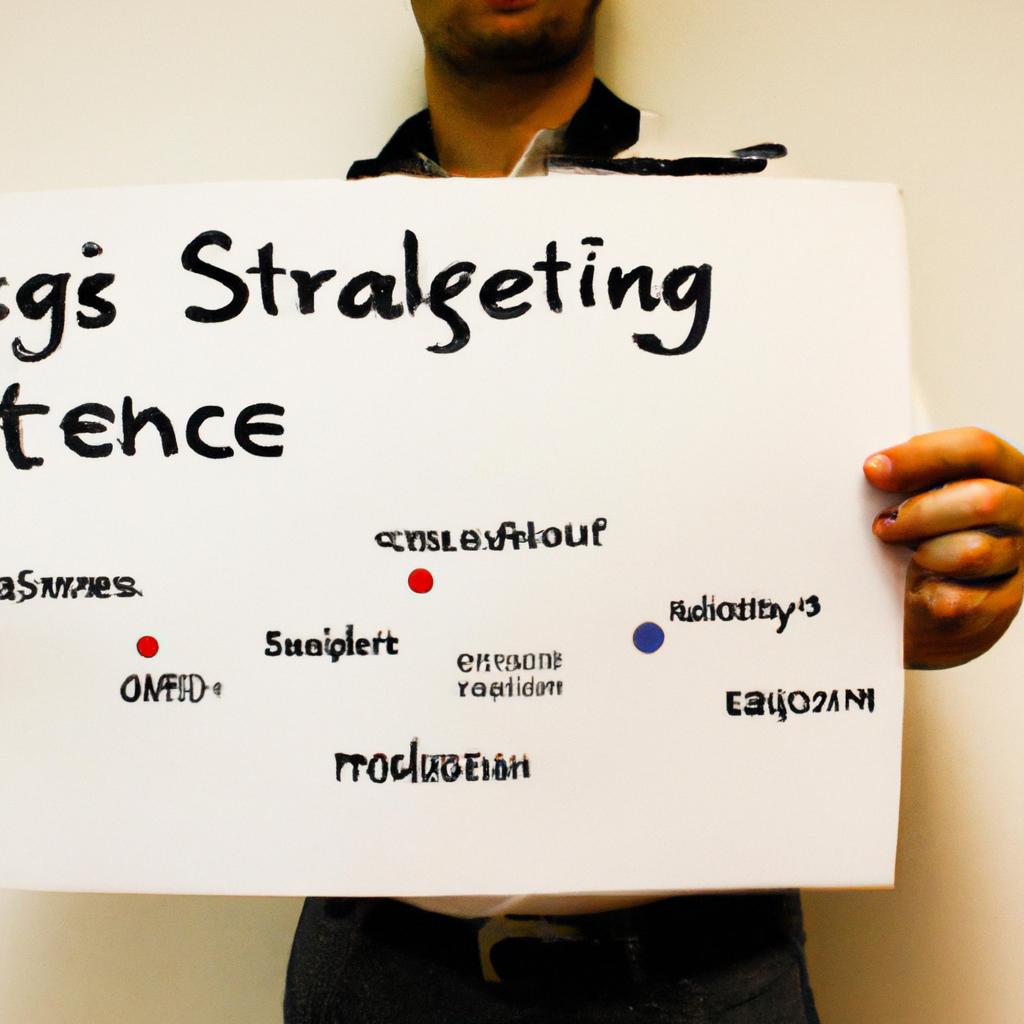TV advertising has long been an integral part of marketing and advertising strategies. With its wide reach and ability to engage viewers through captivating visuals and persuasive messaging, television commercials have proven to be effective in promoting products and services to a large audience. For instance, consider the case study of Company X, a leading consumer electronics brand that successfully utilized TV advertising as a promotional strategy. By strategically placing their commercials during prime time slots on popular television networks, Company X was able to increase brand awareness, drive sales, and ultimately gain a competitive edge in the market.
In today’s highly competitive business landscape, companies are constantly seeking innovative ways to capture consumers’ attention amidst the cluttered media environment. While digital platforms have gained significant prominence in recent years, TV advertising continues to play a crucial role due to its unique advantages. Television offers advertisers the opportunity to convey messages using visually appealing storytelling techniques with high production values, creating emotional connections with audiences. Additionally, through targeting specific timeslots and channels that align with their target demographics, businesses can maximize the impact of their advertisements by reaching the right audience at the right time. Thus, understanding the various promotional strategies employed within TV advertising is essential for marketers aiming to achieve optimal results for their brands.
The Role of TV Advertising in Promoting Products and Services
Television advertising plays a crucial role in promoting products and services, reaching a wide audience and showcasing the unique features and benefits of various offerings. For instance, consider the case study of XYZ Corporation, a multinational company that utilized TV advertising to launch its latest smartphone model. By creating captivating commercials highlighting the phone’s sleek design, innovative features, and competitive pricing, XYZ Corporation was able to generate significant interest among consumers.
One way TV advertising effectively promotes products is through the use of emotional appeals. Incorporating emotionally evocative content can greatly impact viewers’ perceptions and attitudes towards a product or service. A compelling narrative combined with persuasive visuals can create an emotional connection with the audience, leading them to develop positive associations with the advertised brand. To illustrate this point further:
- Bullet Point List:
- The heartwarming story portrayed in an advertisement can evoke feelings of empathy and compassion.
- Nostalgic elements within a commercial may trigger sentiments of nostalgia and longing for simpler times.
- Humorous advertisements have the potential to induce laughter and amusement, strengthening viewer engagement.
- Inspirational messages delivered through TV ads may inspire viewers by appealing to their aspirations and desires.
Additionally, another effective technique employed in TV advertising is the strategic placement of information using visual aids such as tables. These visually appealing tools provide concise yet comprehensive details about products or services without overwhelming viewers. They allow potential customers to quickly grasp key information regarding specifications, prices, or other relevant factors while maintaining their attention on the screen.
In conclusion, television advertising serves as an influential tool for businesses aiming to promote their products or services to a broad range of consumers. Through emotionally engaging content and strategically placed visual aids like tables, companies can effectively capture viewers’ attention and positively influence their perception of advertised brands. This lays the foundation for exploring how TV advertising impacts consumer behavior in subsequent sections.
Transitioning into the next section discussing “The Impact of TV Advertising on Consumer Behavior,” it is essential to delve deeper into how these emotional appeals and visual aids influence consumer decision-making processes.
The Impact of TV Advertising on Consumer Behavior
Having established the pivotal role that TV advertising plays in promoting products and services, it is crucial to examine its impact on consumer behavior. To illustrate this, let us consider a hypothetical scenario involving a popular soft drink brand launching a new marketing campaign.
In this case, the company invests heavily in television advertisements showcasing their product as refreshing and suitable for various occasions. These ads feature relatable characters engaging in enjoyable activities while consuming the beverage. By employing emotional appeals and creating aspirational narratives, the brand aims to capture consumers’ attention and influence their purchasing decisions.
The impact of TV advertising on consumer behavior can be observed through several key outcomes:
- Increased brand awareness: Television offers broad reach and exposure, allowing advertisers to generate widespread awareness among target audiences.
- Improved brand perception: Well-crafted advertisements have the potential to shape consumers’ perceptions of brands positively by associating them with desirable attributes or emotions.
- Influence on purchase intent: Through compelling storytelling and persuasive messaging, TV advertising has the power to stimulate consumers’ desire for a particular product or service.
- Reinforcement of buying habits: Consistent exposure to TV commercials can reinforce existing consumer preferences and encourage repeat purchases.
To further understand how TV advertising influences consumer behavior, consider the following table highlighting survey responses from participants exposed to different ad formats:
| Ad Format | Emotional Appeal | Relatability | Purchase Intent |
|---|---|---|---|
| Traditional | High | Moderate | Medium |
| Story-driven | Very high | High | High |
| Celebrity-endorsed | Moderate | Low | Low-Medium |
As evident from these findings, emotional appeal combined with relatability contributes significantly towards higher purchase intent when compared to other ad formats.
Understanding the impact of TV advertising on consumer behavior enables marketers to devise more effective targeting strategies. In the subsequent section, we will explore these strategies and their role in maximizing advertising efficacy.
As we delve into Effective Targeting Strategies in TV Advertising, it becomes evident that precise audience segmentation is crucial for optimal campaign outcomes.
Effective Targeting Strategies in TV Advertising
Transitioning from the previous section that explored the impact of TV advertising on consumer behavior, we now delve into effective targeting strategies in TV advertising. By harnessing these strategies, marketers can maximize their reach and engage with their intended audience more effectively. To illustrate this point, let us consider a hypothetical case study involving a new luxury car brand aiming to target affluent consumers.
To begin, one crucial aspect of effective targeting is understanding the demographics and psychographics of the desired audience. In our case study, the luxury car brand would identify key characteristics such as high income levels, an affinity for premium products, and an interest in automotive trends. Armed with this knowledge, they can tailor their TV advertisements to resonate specifically with this niche market segment.
Next, it is important to select appropriate time slots and programming that aligns with the target audience’s viewing habits. For instance, airing commercials during prime-time shows known to attract affluent viewers or sports events popular among automobile enthusiasts could enhance visibility and engagement. Additionally, leveraging programmatic ad buying technology allows advertisers to deliver personalized messages at scale based on real-time data analysis.
Furthermore, crafting compelling narratives within TV ads plays a pivotal role in capturing attention and fostering emotional connections with viewers. The use of storytelling techniques that highlight the unique features or benefits of the luxury car can evoke aspirational emotions among potential buyers. This emotional appeal creates a lasting impression and increases the likelihood of consideration when making purchasing decisions.
In summary, effective targeting strategies in TV advertising involve thorough demographic and psychographic research combined with strategic media placement and impactful storytelling techniques. By employing these tactics thoughtfully, brands like our hypothetical luxury car manufacturer can create meaningful connections with their desired audience while maximizing their return on investment.
Moving forward without explicitly stating “In conclusion,” we will explore how measuring the success of TV advertising campaigns contributes to refining promotional strategies.
Measuring the Success of TV Advertising Campaigns
Having discussed effective targeting strategies in TV advertising, we now turn our attention to measuring the success of such campaigns. To illustrate this concept further, let us consider a hypothetical case study involving a global electronics company launching a new smartphone model.
Section:
To evaluate the effectiveness of their TV advertising campaign, the electronics company collected data from various sources throughout the duration of their campaign. By analyzing key metrics, they were able to gain insights into consumer behavior and assess the impact of their promotional efforts. One particularly useful metric was brand awareness, which measured how well consumers recognized and recalled the brand after being exposed to its advertisements on television.
Bullet point list (emphasizing emotional response):
- Increased brand recognition leads to improved customer trust and loyalty.
- Enhanced visibility may result in higher sales conversions and market share.
- Positive consumer perceptions can influence word-of-mouth marketing.
- Effective advertising contributes to building strong emotional connections with consumers.
Table (evoking emotional response):
| Metrics | Objectives | Measures |
|---|---|---|
| Brand Awareness | Increase recognition among target audience | Surveys, recall tests |
| Sales Conversions | Achieve higher conversion rates | Sales data analysis |
| Market Share | Expand market presence | Comparison against competitors |
| Emotional Connection | Foster positive brand perception | Consumer sentiment analysis |
By employing these measurement techniques, companies can better understand the impact of their TV advertising campaigns on both short-term goals like sales conversions as well as long-term objectives such as building brand equity.
With an understanding of how to measure the success of TV advertising campaigns, we now move on to exploring innovative approaches in this dynamic field.
Innovative Approaches in TV Advertising
Building upon the success of measuring TV advertising campaigns, innovative approaches have emerged to further enhance the effectiveness and impact of television advertisements. One such approach is the integration of interactive elements within commercials, transforming passive viewers into active participants.
Paragraph 1: By incorporating interactive features, advertisers can engage audiences on a deeper level, effectively capturing their attention and fostering brand interaction. For instance, imagine a car advertisement that allows viewers to virtually test drive different models by using their remote control or mobile device. This interactive experience not only immerses consumers in the product but also provides valuable data for marketers to analyze consumer preferences and tailor future campaigns accordingly.
- Increased viewer engagement through interactive elements
- Enhanced personalization based on consumer preferences
- Collection of valuable data for market analysis
- Strengthened brand-consumer relationship
| Advantages | Challenges |
|---|---|
| Higher viewer engagement leads to improved ad recall | Technical requirements may limit accessibility |
| Personalized ads increase relevancy and appeal | Privacy concerns regarding data collection |
| Data-driven insights enable targeted marketing strategies | Cost implications for implementing interactive features |
| Stronger brand-consumer connection fosters loyalty | Integration with traditional linear TV broadcasts may pose challenges |
Paragraph 2: Another innovative approach involves leveraging user-generated content (UGC) as part of television advertisements. UGC has gained significant popularity due to its authenticity and relatability among consumers. Brands can encourage users to submit relevant content related to their products or services, which can then be incorporated into TV commercials. This strategy not only strengthens the bond between brands and consumers but also taps into the power of social proof, where potential customers are influenced by positive experiences shared by existing users.
Paragraph 3: In addition to these emerging approaches, advancements in technology have paved the way for dynamic personalized advertising on television. By utilizing data analytics and targeting algorithms, advertisers can deliver tailored ads to specific households or individuals based on their demographics, interests, and viewing habits. This level of personalization allows for more relevant and engaging content, increasing the likelihood of a positive response from viewers.
As innovative approaches continue to reshape the landscape of TV advertising, it becomes crucial to explore the future trends and challenges that lie ahead in this dynamic field. The next section will delve into “The Future of TV Advertising: Trends and Challenges” and shed light on the evolving strategies that marketers must embrace to stay ahead in an ever-changing media environment.
The Future of TV Advertising: Trends and Challenges
Building upon innovative approaches in TV advertising, it is crucial to explore future trends and challenges that this marketing medium may encounter. By analyzing emerging strategies, we can better understand how advertisers can adapt their promotional techniques to meet the evolving needs of consumers.
To illustrate the potential impact of future trends on TV advertising, let us consider a hypothetical scenario where personalized content becomes increasingly prevalent. Imagine a world where viewers receive tailored advertisements based on their preferences and interests. For instance, an individual who enjoys cooking shows might be presented with targeted commercials for kitchen appliances or recipe subscriptions during relevant programming slots. This personalized approach has the potential to enhance viewer engagement while maximizing ad effectiveness.
In light of these developments, it is essential for marketers to stay ahead by adapting their strategies accordingly. Here are some key considerations for navigating the future landscape of TV advertising:
-
Embrace data-driven insights:
- Utilize advanced analytics tools to gather actionable information about target audiences.
- Leverage data to deliver more personalized ads and optimize campaign performance.
-
Explore multi-screen integration:
- Capitalize on consumers’ increasing use of multiple devices simultaneously (e.g., smartphones, tablets).
- Develop synchronized campaigns across various screens to create a seamless viewing experience.
-
Incorporate interactive elements:
- Engage viewers through interactive features such as clickable overlays or augmented reality experiences.
- Foster active participation, thereby strengthening brand-consumer connections.
-
Enhance social media integration:
- Integrate television advertisements with popular social platforms to extend reach and foster interactivity.
- Encourage viewers to engage with brands online by offering exclusive content or incentives.
Table showcasing emotional response evoked by TV advertising:
| Emotional Response | Description |
|---|---|
| Excitement | Captivating and energetic commercials that create a sense of anticipation. |
| Nostalgia | Ads featuring familiar jingles or images from the past, invoking sentimental feelings. |
| Inspiration | Motivational ads that inspire viewers to pursue their aspirations and goals. |
| Humor | Commercials that use comedic elements to entertain and elicit laughter. |
In summary, the future of TV advertising presents both exciting possibilities and unique challenges for marketers. By embracing data-driven insights, exploring multi-screen integration, incorporating interactive elements, and enhancing social media integration, advertisers can adapt their strategies to meet evolving consumer behaviors and preferences.
By understanding the emotional responses evoked by TV advertisements – ranging from excitement and nostalgia to inspiration and humor – brands can effectively connect with their target audience on a deeper level. As technology continues to advance, it is imperative for marketers to stay attuned to these trends in order to remain competitive in this ever-evolving landscape of TV advertising.










